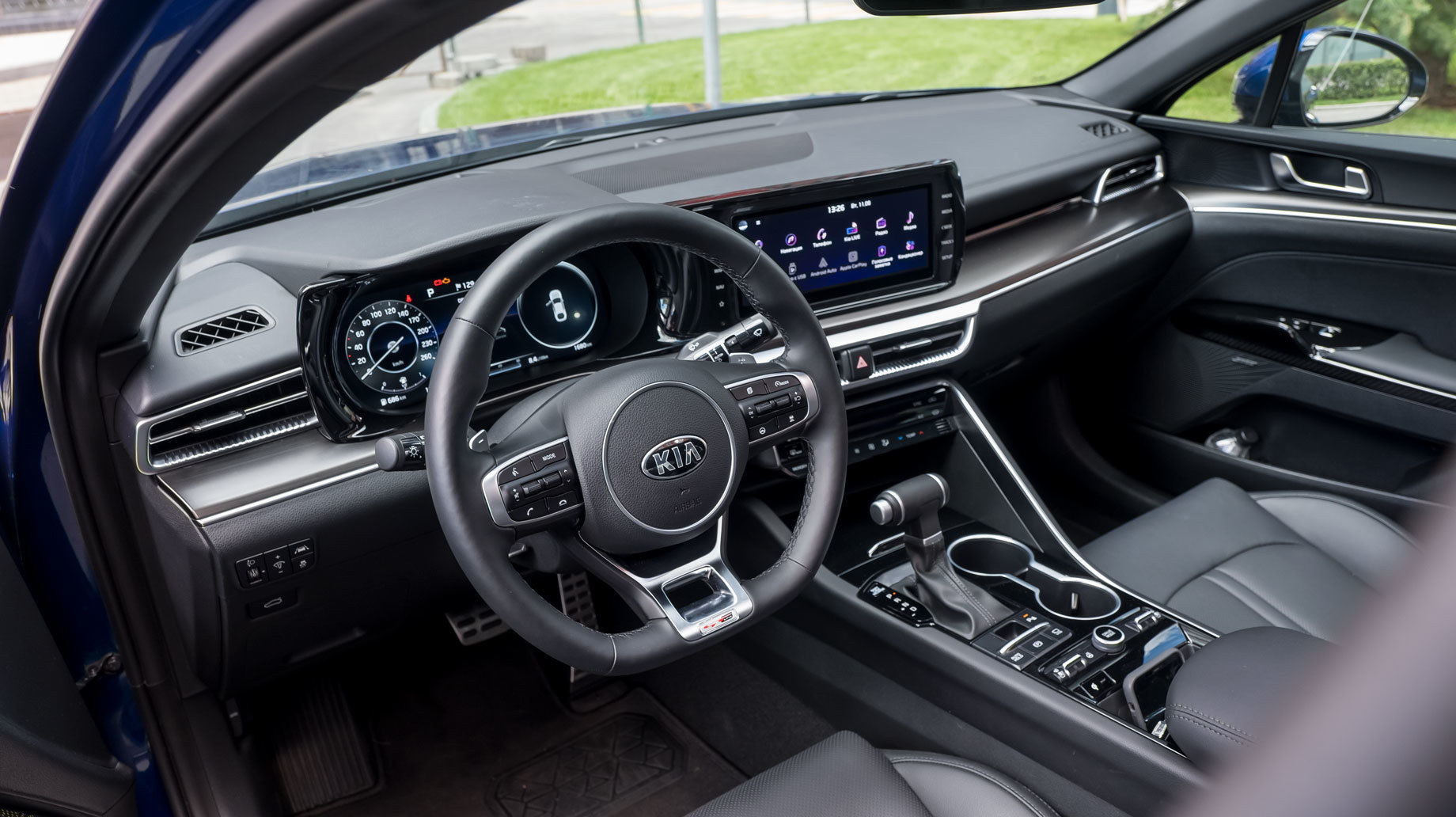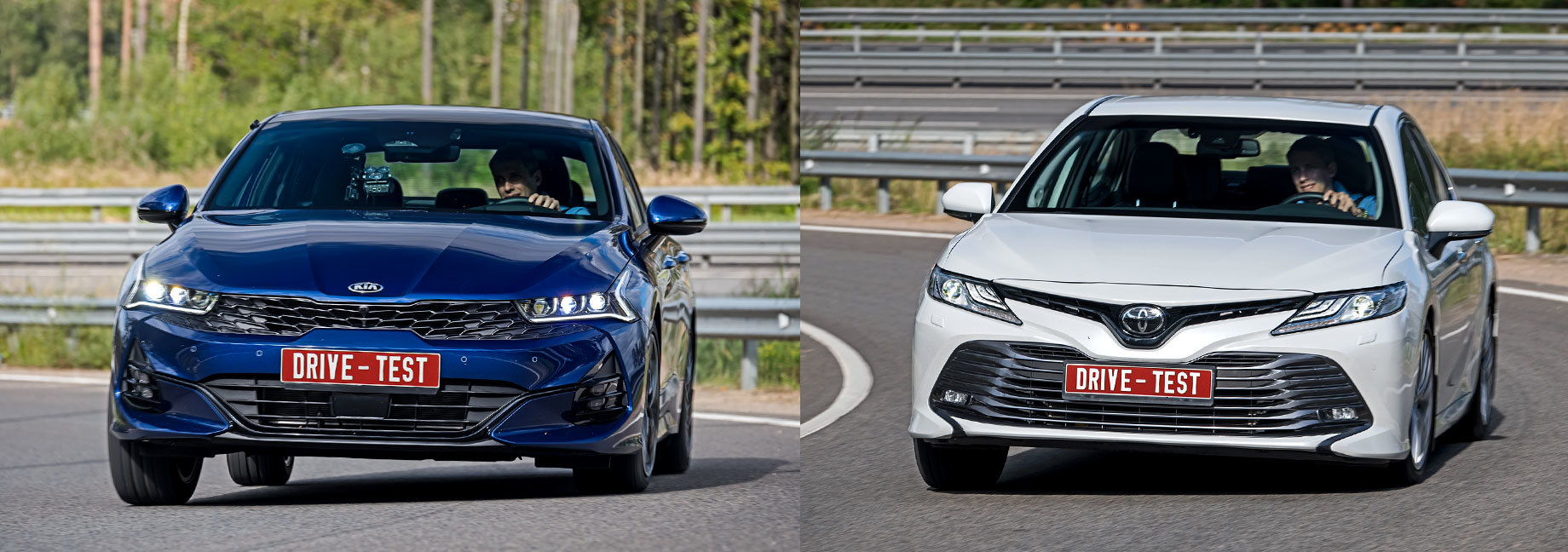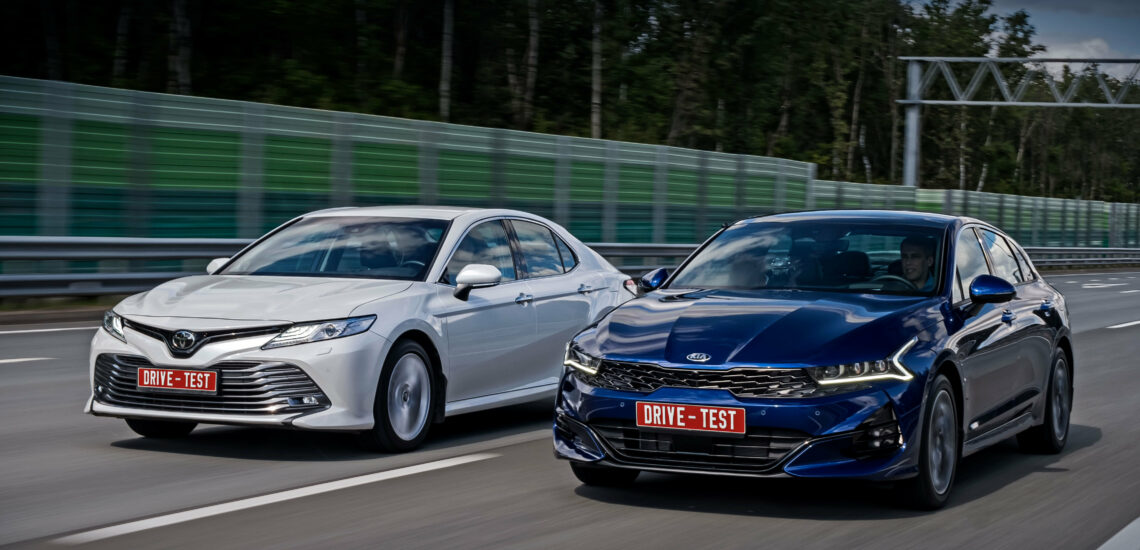We can say that there are three of them in this test. There is no escaping the new Sonata with which the K5 sedan, that replaced the Optima, shares a platform. In this case, their relationship is not formal, as between the Camry and other TNGA cars. The two “Koreans” are very similar: both by the internal space planning of the same body type, and on the move. The K5 drives a little more interesting – this is understandable because it primarily competes with Toyota’s bestseller.
Well, let’s not forget about the outgoing Optima. It did what it could: over the past five years, its presence in the segment has increased from four percent to 34% in 2019, when the Camry held 45% of the class. Koreans tend to evaluate success with shares, so a falling market can play into their hands, especially since they have proven their ability to benefit from crises. Although the Camry is resistant to shocks: the worse the year, the bigger its piece of cake.

Kia emphasizes the image of a global model: contrary to the usual ideas about production optimization, the K5 came to us with an original power unit. The Smartstream 2.5 naturally aspirated engine belongs to the same Theta III family as the Sonata’s “four”, but develops 194 hp instead of 180 thanks to the addition of direct injection. There are not six, but eight gears in the new automatic transmission of HMG’s own design. The Camry 2.5 (181 hp) hasn’t received an eight-speed gearbox yet.
The K5 looks strange. The shape of the radiator grille is still called the “tiger smile”, but at the same time they say that the pattern of the cells should resemble scales of shark skin. That is, the tiger ate the shark, that’s why its face is so tense. But have you seen yours when seafood gets stuck in your teeth? However, the reverse tilt of the grille, for example, reminded Robert, who is helping me today, of the “Eighth” Galant. In any case, there seems to be no familiar Toyota next to the K5 at all.
The K5 inside is a gadget compared to both the Optima and the Camry. Large ten-inch displays and touch panels are combined with handles and buttons on the tunnel. The architecture is successive: the horizontal dominates, the two-level center console is turned towards the driver. Plastic of the front panel is sharper than in the Sonata, but the fit is just as high. The pose in a stiff seat mobilizes you, a nice steering wheel in the already criticized sticky leather can be pulled close to yourself. The materials in the Toyota are not worse, but the fittings are simpler. The comfortable cabin of the Camry is much more conservative, and multimedia is not developed. But you sit lower, and a soft seat distributes the load better.
Bearing in mind the absolutely bland driving character of the Sonata, I’m looking for a highlight in the habits of the K5 and I don’t find it. Except that the Kia is more focused than the Hyundai in the winter test, overcomes large bumps and doesn’t knock with suspensions. But the gait is still a bit stiff, harder than the Optima’s one. You need to slow down a lot before speed bumps in order to avoid impacts. The K5 is not annoying on ordinary city asphalt, but there are more disturbances and noise from the road coming into the cabin than in the Camry, even on unsuitable 18-inch wheels with Bridgestone Turanza T005 A tires.

The power unit of the “Korean” is sufficient and unremarkable. But against the background of the Camry with a terribly damped accelerator, the K5 provides much more precise acceleration control. However, there is no talk about claimed 8.6 seconds to hundred km/h: the lowest time recorded by Racelogic is worse than nine and a half seconds. The Kia refuses to start abruptly, no matter what I do with the pedals, so the Toyota, confirming the passport data, is quite successful with a small lag at a parallel start.
Having lost a little in ride smoothness relative to the predecessor Optima, the K5 gained a little in steerability. But compared to the new Sonata, the difference in behavior is barely perceptible. Above all, It is safe. Reactions to steering commands are calm and predictable, rolls are moderate. The Kia draws the limit arc without the front sliding. It barely notices changes in fuel supply, firmly leaning on both outer wheels in decent tires. I fall out of the flat seat much earlier than the Continental Premium Contact 6 loses its grip. But the force on the steering wheel is artificial, grows incongruously with lateral loads and requires a tangible impulse to get out of zero.
The Camry on the trivial Turanza demonstrates a very close maximum speed in the control turn. It is more difficult for the crank Toyota to do it, you have to work with the car, but the whole process is absolutely natural and full of small events. The heavy sedan responds vividly to the steering wheel turning, then rolls rapidly, then goes to a steeper radius, playing along with the rear suspension and demanding dissolution. Kinematic liveliness and sensitivity to mass redistribution gives more opportunities to control the trajectory.
At the everyday level, both cars are clear and easy to operate. But the Camry settings leave freedom for the development of the relationship between the car and the skilled driver. The Kia reads like an open book from the first meters, remains unambiguous at any speed, and potential discoveries are waiting for you only somewhere in the depths of a sophisticated multimedia system. Or, for example, in the list of limitations of the five-year warranty.

I didn’t see any prerequisites neither for a rapid rise of the K5, nor for failure. The newcomer carefully takes the baton from the Optima with cautious changes in the configuration and a slight shift in emphasis in the chassis adjustment. The positioning of the relatively more comfortable and conservative Camry doesn’t change, but the expensive versions of the K5 create new points of attraction, for example, for the Mazda 6 buyers due to the catchy design and rich multimedia.
The formally largest sedan of the class (though the count goes by millimeters) is offered at the lowest price. But the basic equipment with air conditioning and a plastic steering wheel rim will satisfy only rentals. The most popular version 2.0 Comfort has risen in price compared to the Optima. And the multimedia display will be an eight-inch there, albeit with support for Apple CarPlay/Android Auto protocols.
It is interesting to look now at the sales of the Sonata, because it offers more interesting options for a small additional fee. For example, the Sonata 2.0 Comfort is equipped with 17-inch wheels. In the K5, they appear only in the Luxe configuration with the same engine. Relative to the Optima, this fulfillment has slightly risen in price. The price growth is heterogeneous: the GT Line version, which was very popular in the past, added a substantial amount at once. It is, of course, elegant, like an exhibition showcase, but there is no highlight. And for this money, they will without question give you the 245-horsepower supercharged Optima GT – the main “lighter” of the class.
This is a translation. You can read the original here: https://www.drive.ru/test-drive/kia/toyota/5f32e268ec05c43668000004.html

Published September 29, 2022 • 6m to read






